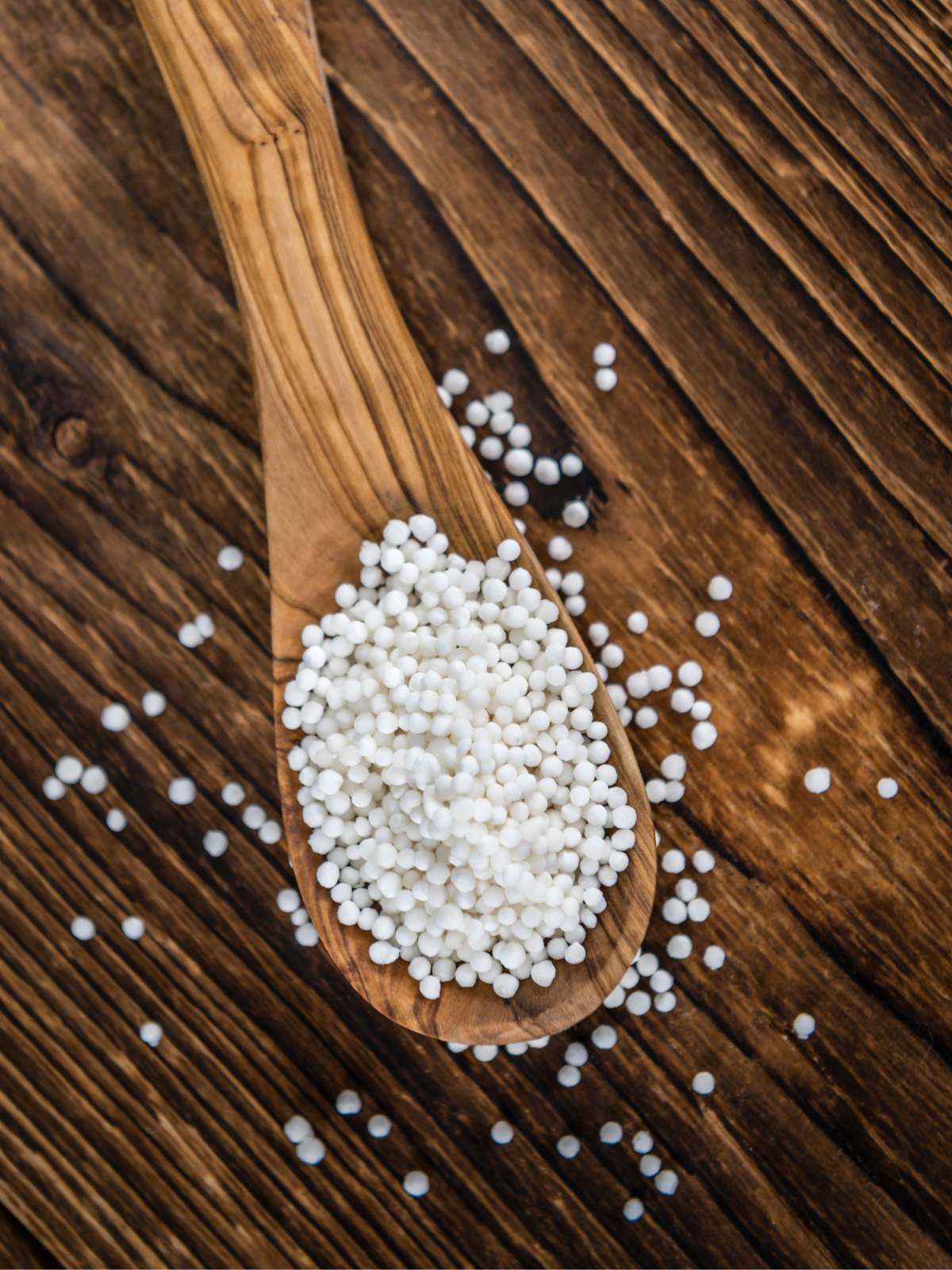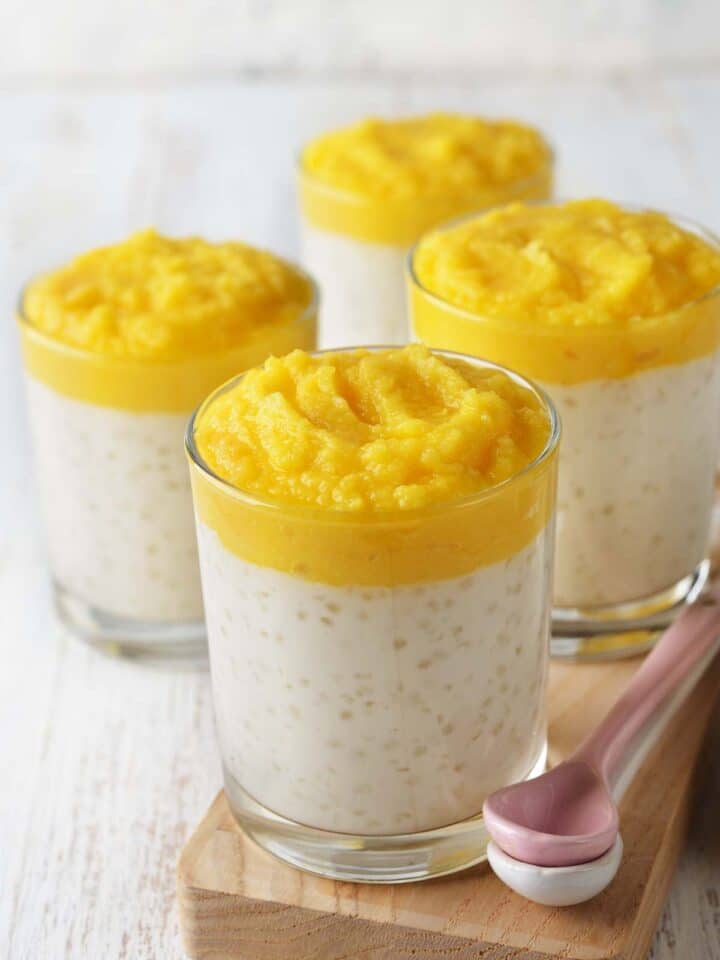This chewy, flavorful treat is beloved by many for its unique texture and versatility, but if you’re a vegan, you might be wondering if tapioca is a snack that you can indulge in guilt-free. So, is tapioca vegan? The answer might surprise you! Let’s dive into the world of tapioca and find out.
This post may contain affiliate links. Read my policy page for more information.

Is Tapioca vegan? Today we’ll explore this question further, as well as dive into what are the health benefits of tapioca, how it’s made, and what are its uses. Let’s get started!
Tapioca is the main ingredient behind the popular Bubble milk tea, as well as a common ingredient in many food products.
Not only does it act as an excellent thickening agent, but it’s also quite versatile in a number of different recipes.
While tapioca comes in various forms, tapioca starch and tapioca flour are the two most popular ones. So, today we’ll mainly talk about them.
Jump to:
What is Tapioca?
Tapioca is a starchy substance that comes from the cassava plant, which is native to South America. The cassava plant is also known as yuca or manioc, and has been a staple food source in many cultures for thousands of years.
The most common forms that tapioca comes in are:
- Boba balls – These are made by extracting the starch from the cassava root and processing it into small pearls, which are then cooked and used in a variety of dishes.
- Tapioca starch – Extracted from the cassava root. For that reason, it’s sometimes called cassava root starch or manioc starch, depending on the region.
- Tapioca flour – Also known as manioc flour, this is a non-wheat flour that’s often used in gluten-free baking.
Note: Тapioca starch and tapioca flour are often mistaken to be the same thing, but they are not. Later in this article, we will explore the differences between them.
Tapioca is a unique ingredient because of its chewy, jelly-like texture. It’s often used as a thickener in desserts and drinks, and it can also be boiled and served as a side dish. In fact, tapioca pudding is a popular dessert in many countries, and it’s often flavored with vanilla or fruit.
Tapioca pearls can also be found in drinks like bubble tea, where they add a fun and playful texture to the drink. With its versatility and distinctive texture, tapioca is a fun and exciting ingredient to experiment with in the kitchen!

How is it made?
You can have many products made from tapioca, including pearls, powder, flour, and even things like chips, pasta, and noodles. They all have different methods of preparation.
The most common- tapioca starch, is made from extracting the starches of cassava root.
The first step is to harvest and clean the roots. Then they’re grated into a fine pulp.
The pulp is then squeezed to extract the starchy liquid.
After that, the liquid is dried and ground into a fine tapioca powder. This results in tapioca starch as we know it today.

Is Tapioca vegan?
Yes, tapioca of any kind is naturally vegan and doesn’t contain any animal products. It’s made from a root vegetable after all.
The context it’s used in is what also matters. Often tapioca can be prepared with other animal-based products that can be sneaky or hard to identify.
For example, Bubble milk tea (also known as Boba tea) is made from tapioca balls. However, the drink often contains dairy products like milk or cream.
While tapioca is 100% vegan, it’s important to think about the rest of the ingredients that go into preparing something. Ask for an ingredient list when necessary.
What is it used for?
As we’ve established by now, Tapioca comes in many different forms, which makes it a versatile ingredient that can be used in many ways.
Here are some of the most common ways to use tapioca:
- As a thickener: Tapioca starch is often used as a substitute for cornstarch in recipes that need thickening. Depending on how much you’re using, it can give foods a pudding-like consistency, similar to how I used cornstarch in my healthy vegan lemon bars to thicken the mixture. In small amounts, it can create a sticky glaze or sauce, which is why I added cornstarch to my marinated air fryer tempeh.
- As a binder: Similar to wheat flour and chickpea flour, tapioca starch can work as a binder in recipes like vegan patties, sausages, fritters, and more!
- In vegan cheese: If you have been following a vegan diet for a while now, you probably know that most recipes for vegan cheese call for some kind of thickener, whether that’s corn starch or tapioca starch.
- In gluten-free baked goods: Tapioca flour can be used as a substitute for regular wheat flour in things like gluten-free bread, cookies, cakes, etc. It’s most common to use it with a mix of other gluten-free flours to achieve a better texture.
- Bubble milk tea aka Boba tea: Usually served cold, this is a drink made from tea, milk, sugar, and cooked boba pearls at the bottom. It’s refreshing, sweet, and fun to drink! When ordering, make sure to ask for dairy-free milk such as coconut milk or almond milk to ensure that your drink will be vegan.
- Tapioca pudding: It’s made with small pearl tapioca that has been cooked in milk, sugar, and sometimes eggs, depending on the recipe. You can make vegan tapioca pudding recipe at home—it’s delicious, creamy, and naturally gluten-free.
Tapioca starch vs. Tapioca flour
While some sources online state that tapioca flour and tapioca starch are the same thing, they actually have several differences.
Yes, they’re both made from the same thing—the tapioca root, but with a different process.
As we’ve discussed earlier, tapioca starch is the extracted starch from the cassava root. Notice the word “extracted” here, it’s 100% processed starch.
Tapioca flour, on the other hand, is made from the whole cassava root. The root is ground into a fine white powder, similarly looking to tapioca starch, but it has more fiber, protein, and overall nutrients.
The main difference, however, is in their texture. While tapioca starch has a fine powdery texture, tapioca flour is similar to white flour.
It’s also slightly sweet and nutty, which can complement some recipes.
Nutritional value
Tapioca is made entirely from carbohydrates and provides little to no nutritional value.
While it’s gluten-free and grain-free, it doesn’t contain any protein, fiber, or healthy fats.
It can be considered a source of “empty” calories. It’s not a good source of any essential vitamins or minerals such as vitamins C, D, or A, nor iron or calcium. One cup of dry tapioca pearls provides 544 calories, but not much else.
It’s best to consume tapioca starch and tapioca flour in moderation or combine them with other high-fiber and high-protein foods.
FAQ
No, tapioca is naturally vegan and dairy-free and doesn’t contain any animal ingredients.
No, tapioca doesn’t contain any gelatin. It’s almost entirely made from starch (depending on the product), which is a thickener in and of itself.
Yes, tapioca is naturally gluten-free, and grain-free! It’s a great substitute for wheat flour if you’re following a gluten-free or grain-free diet.
Best Substitutes
Are you out of tapioca starch? Here are the 5 best substitutes you can use!
- Cornstarch: If you don’t have tapioca starch on hand, cornstarch would be your best bet. It can produce slightly different results, depending on the recipe, but it has a very similar texture and can be substituted in equal amounts.
- Arrowroot starch: This is a starch made from the arrowroot plant. It has a neutral flavor, is gluten-free, and can be used as a direct substitute for tapioca starch with a 1:1 ratio.
- Potato starch: It has a neutral, slightly sweet flavor and looks very similar to tapioca starch. You can use it as a substitute with a 1:1 ratio.
- Rice flour: Made from finely ground rice, it’s a great gluten-free alternative you can use to thicken sauces and soups, as well as in baking. While it’s best to use a 1:1 ratio, note that rice flour is a weaker thickening agent compared to tapioca starch, so you may need to add slightly more.
- All-purpose flour: It’s a budget-friendly and convenient ingredient, and can work as a substitute for tapioca starch in most cases. As with rice flour, it’s not as powerful a thickener, so you may need to add more. Keep in mind that this option is not gluten-free, so it’s not suitable for people with celiac disease.

Summary
To wrap it all up, tapioca products are 100% vegan, but not every food that contains tapioca is.
It’s best to look at the ingredient list or ask whether something contains animal products or not.
Tapioca is also great for those following a gluten-free diet, or looking to cut back on wheat and gluten-containing foods.
More vegan questions answered
- Read up on whether pasta is vegan plus best brands and homemade recipes.
- Find out if your favorite ramen brands are vegan and which products are vegan-friendly.
- Wondering if Cool Whip is Vegan? Here’s the definitive answer, plus which other brands are vegan and easy substitutes.
- How long does Tahini last? plus an easy homemade tahini recipe you gotta try!
- Nutritional yeast explained with a simple nutritional yeast parmesan recipe!









